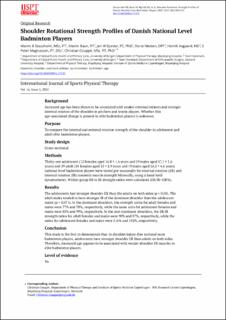Shoulder rotational strength profiles of danish national level badminton players
Stausholm, Martin Bjørn; Baun, Martin; Bjordal, Jan Magnus; Nielsen, Dorte; Aagaard, Henrik; Magnusson, S. Peter; Couppé, Christian
Journal article, Peer reviewed
Published version

Åpne
Permanent lenke
https://hdl.handle.net/11250/2888307Utgivelsesdato
2021Metadata
Vis full innførselSamlinger
Originalversjon
International Journal of Sports Physical Therapy. 2021, 16 (2), 504-510. 10.26603/001c.21531Sammendrag
Background
Increased age has been shown to be associated with weaker external rotators and stronger internal rotators of the shoulder in pitchers and tennis players. Whether this age-associated change is present in elite badminton players is unknown.
Purpose
To compare the internal and external rotation strength of the shoulder in adolescent and adult elite badminton players.
Study design
Cross-sectional.
Methods
Thirty-one adolescent (12 females aged 16.8 ± 1.6 years and 19 males aged 17.1 ± 1.6 years) and 29 adult (10 females aged 25 ± 2.9 years and 19 males aged 26.2 ± 4.6 years) national level badminton players were tested pre-seasonally for external rotation (ER) and internal rotation (IR) isometric muscle strength bilaterally, using a hand-held dynamometer. Within-group ER to IR strength ratios were calculated (ER/IR×100%).
Results
The adolescents had stronger shoulder ER than the adults on both sides (p < 0.05). The adult males tended to have stronger IR of the dominant shoulder than the adolescent males (p = 0.071). In the dominant shoulders, the strength ratios for adult females and males were 77% and 78%, respectively, while the same ratio for adolescent females and males were 85% and 99%, respectively. In the non-dominant shoulders, the ER/IR strength ratios for adult females and males were 90% and 87%, respectively, while the ratios for adolescent females and males were 116% and 102%, respectively.
Conclusion
This study is the first to demonstrate that in shoulder injury-free national team badminton players, adolescents have stronger shoulder ER than adults on both sides. Therefore, increased age appears to be associated with weaker shoulder ER muscles in elite badminton players.
